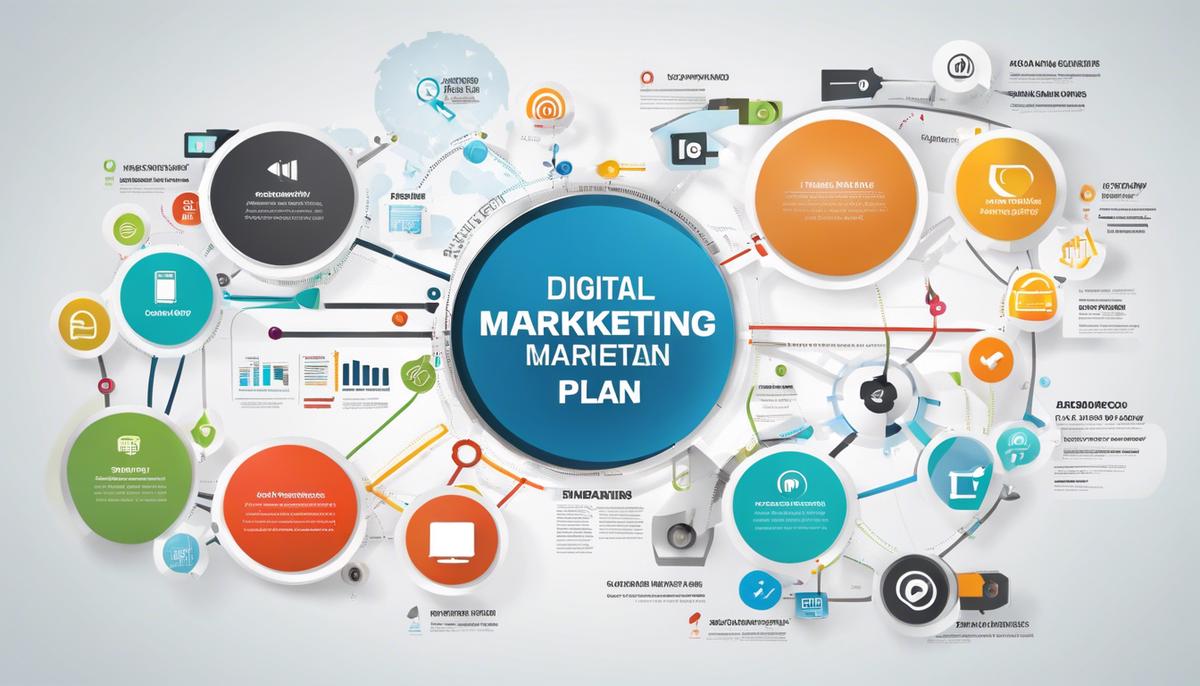Digital marketing for SMEs – from mastering the basics to advanced tips and tricks.
In today’s digital age, Small and Medium Enterprises (SMEs) stand at the threshold of opportunity, where the right online strategies can catapult them into unprecedented growth. Harnessing the power of digital marketing is not just a luxury but a necessity for these burgeoning businesses seeking to carve out their market share. With a landscape so vast and varied, the crafting of a digital marketing strategy tailored specifically to an SME’s unique business model is paramount. By delving into a world where every click is measurable and every campaign can be optimized, this essay embarks on a journey to demystify the art and science of digital marketing designed to elevate the presence and profitability of SMEs.
Crafting a Tailored Digital Marketing Strategy
Devising a Cutting-Edge Digital Marketing Plan for Your SME: A Roadmap to Success
In the fast-evolving digital arena, a robust digital marketing plan isn’t just advisable for small and medium-sized enterprises (SMEs); it’s a necessity to survive and thrive. With the digital landscape providing an equal footing for businesses of all sizes, the right strategies can propel an SME to outstanding heights. Let’s dive into the imperative steps required to craft a remarkable digital marketing plan that not only addresses market needs but also leverages current trends and networking prowess to maximize impact.
Target Market Identification: Precision Equals Profit
Understanding your audience is the cornerstone of a successful digital marketing initiative, without which efforts could go astray. It begins with comprehensive market research, utilizing tools like audience analytics, surveys, and competitor analysis. Pinpoint the demographics and psychographics of the customer base, then tailor the digital marketing plan to speak directly to their needs and pain points.
Goals and KPIs: Set to Scale and Measure
Outline clear, attainable goals that align with overall business objectives. Whether it’s brand awareness, lead generation, or e-commerce sales, these goals must be SMART: Specific, Measurable, Achievable, Relevant, and Time-bound. Corresponding Key Performance Indicators (KPIs) will then serve as the navigational stars, guiding the SME through the digital terrain with metrics that measure success accurately.
SEO and Content Marketing: The Dynamic Duo
A cutting-edge digital marketing plan leans heavily on the synergy between Search Engine Optimization (SEO) and quality content. Identify high-value keywords and optimize web content, blogs, and articles to improve search engine rankings. Not only does this drive organic traffic, but it establishes the SME as an industry thought-leader when content resonates and provides value to the target audience.
Leverage Social Media: Build Community and Engagement
Social media is the marketplace where conversations happen and brands come to life. Customizing the approach for each platform, engaging with followers, and creating shareable, interactive content fosters a community around the SME’s brand. Here, authenticity and creativity reign, as they fuel the spread of brand messaging through the digital word-of-mouth.
Embrace Video Marketing: The Frontier of Engagement
Video content is indispensable in the modern digital strategy. With increasing precedence given to videos in algorithms, incorporating video marketing can amplify reach and engagement significantly. SMEs should create diverse video content such as tutorials, product demos, or behind-the-scenes footage to captivate and educate their audience.
Email Marketing: The Undisputed ROI Champion
Despite the rise of new platforms, email marketing continues to deliver an unmatched return on investment. Personalization and segmentation go a long way to ensure messages cater to the specific interests and needs of subscribers, which drives higher open rates and conversions.
Data Analytics: Gauge and Pivot
Implementing a data-driven approach empowers SMEs to make informed decisions. By analyzing traffic, interaction, conversion data, and more, the business can adjust tactics to better meet goals, shift resources where they are most effective, and anticipate trends before they become mainstream.
Innovation and Continuous Learning: Forever Forward
The landscape is not static, and neither should be the marketing approach. Stay ahead by adopting the latest technologies, practices, and platforms. Think AI, chatbots for customer service, or immersive AR experiences. Commit to learning and innovating constantly.
To truly compete in the digital sphere, SMEs must not only keep up with the pace of change but also anticipate and set trends. A brilliant digital marketing plan is multifaceted, dynamic, and relentless in the pursuit of excellence and growth. Through meticulous planning, an unwavering focus on the target audience, and the agile and creative use of technology and data, SMEs can forge powerful connections with their market and realize their full potential in the digital space.

Leveraging Social Media for Brand Growth
Unlocking the Secrets to Social Media Success for SMEs
In a world where the social media space has evolved from a virtual hangout zone to a battleground of brands vying for consumer attention, Small and Medium-sized Enterprises (SMEs) need to deploy strategic moves to ensure their victory. Social media success isn’t about flooding platforms with content; it’s about finding the nexus between smart tactics and authentic engagement, turning your audience into advocates.
Personalization at Scale: Social media platforms swim in data, offering unprecedented opportunities to personalize content. SMEs can harness the power of analytics tools to tailor messaging that resonates with the individual preferences of their followers, making each interaction feel special and direct. By segmenting the audience and automating personalized responses to consumer behavior, SMEs can create a micro-marketing environment that speaks volumes about understanding customer needs.
Influencer Partnerships: Word of mouth in cyberspace comes from influencers. Their endorsement can vault a brand from obscurity to recognition. SMEs should judiciously choose influencers whose values align with their brand ethos, and whose followers mirror the desired target audience. These collaborations, ranging from long-term associations to short-term shout-outs, can amplify reach and lend credibility that advertising dollars simply cannot buy.
Social Listening: Proactive listening is a staple of any successful business strategy. Social listening goes beyond monitoring mentions or tracking hashtags. It is about plunging into the buzz of real-time conversations, grasping sentiment, and discerning trends. For SMEs, social listening can fine-tune product development and uncover gaps in customer service—this agility in adaptation can transition users from satisfied customers to loyal champions.
Humanize the Brand: With a deluge of content, the human connection is often washed away in the digital expanse. SMEs should strive to humanize their brand by showcasing stories, highlighting team members, and sharing behind-the-scenes glimpses. Audience engagement scales when they connect with a face, a story, or an experience. Every post, live stream, or tweet should remind followers that there are genuine people behind the brand, fostering a community that relishes in authentic experiences.
Optimize for Mobile: A majority of social media browsing occurs on mobile devices, making mobile optimization critical. SMEs must ensure their social media content is visually appealing and accessible on smartphones and tablets. Quick load times, responsive designs, and mobile-friendly formats are imperative. Adapting to the ‘thumb-scrolling’ culture not only captures attention but keeps your brand top-of-mind for on-the-go consumers.
Leverage User-Generated Content: There’s a goldmine in content created by users—reviews, testimonials, photos, or videos showcasing your product. SMEs should encourage and curate such content, as peer recommendations are pivotal in influencing purchase decisions. User-generated content exemplifies trust and sincerity, and when shared, it can generate organic reach and authenticity that meticulously crafted campaigns may not achieve.
Smart Collaboration with Complementary Brands: The principle of synergy suggests that the total output of combined forces is greater than the sum of their individual efforts. SMEs can partner with non-competing, complementary brands to co-create content, share audiences, and run joint promotions. This strategy broadens reach, slashes marketing expenses, and introduces your brand to new, relevant prospects within a trusted context.
Remember, the key to social media success for SMEs lies in cultivating relationships, delivering value, and maintaining a pulse on the evolving digital sphere. Whether it’s through data-driven personalization, strategic partnerships, or compelling storytelling, the objective must always be to create a meaningful and memorable brand experience. When executed with finesimple, these secrets unlock the door to social media stardom for SMEs, heralding a new era of customer connection and commercial triumph.

Maximizing ROI with Email Marketing
In a landscape where cutting-edge innovation and a forward-leaning strategy define top-tier business operations, email marketing remains a cornerstone for SMEs (Small and Medium Enterprises) poised to capture market share and solidify consumer rapport. As digital communication channels proliferate, email marketing has evolved, leveraging bespoke content to resonate with an audience whose attention is fragmented across myriad platforms.
Optimization of email marketing begins with a surgical approach to segmentation. Cutting through the noise demands a deliberate strategy that places bespoke messaging directly into the inboxes of well-defined user segments. This is not merely grouping by basic demographics; it’s a pivot towards behavior-driven email segmentation. Tracking user interaction and purchasing behavior across platforms enables SMEs to curate content that aligns with their audience’s life cycle stage, increasing open rates and catalyzing conversion.
Automation stands out as an indispensable tool for SMEs, offering not just efficiency but also the opportunity to engage customers with the right message at the right time. Drip campaigns – a sequence of emails triggered by specific actions – promise to nurture leads and customer relationships. Automated email campaigns ensure that a high-touch approach to marketing doesn’t overtax resources or bandwidth.
The power of CTAs (Call To Action) cannot be understated. By crafting compelling and clear CTAs, paired with an aesthetically pleasing design, SMEs can guide the consumer through the buyer’s journey from awareness to decision point seamlessly. Additionally, A/B testing variations of CTAs provides a wellspring of data, enabling businesses to fine-tune their messaging for maximal impact.
Integration with CRM (Customer Relationship Management) systems marks another frontier for optimizing email marketing. This harmonization enables SMEs to wield a 360-degree view of the consumer, ensuring that each email sent not only informs but also adds value based on the customer’s relationship with the brand. It’s a move towards creating an ecosystem where each interaction with a customer is part of a larger, ongoing conversation.
Revisiting the concept of precision in content creation, the development of dynamic content serves high engagement on a silver platter. Emails that feature content which morphs based on the user’s previous interactions, geographic location, or other data points redefine relevance in customer communication. These dynamic emails are not just read but experienced, enhancing customer engagement and retention.
Unleashing the power of analytics in email marketing, beyond open and click-through rates, unmasks deeper insights. Cohort analysis and customer lifetime value prediction offer an enhanced understanding of the long-term health of a customer base, informing content and strategy development that is laser-focused on growth and sustained engagement.
Lastly, compliance should be etched into the core of email marketing strategies. SMEs must stay abreast of regulations such as GDPR to maintain trust and ensure their marketing communications are welcomed, not just permitted. This commitment to ethical practices sets a precedent for the brand’s integrity and fosters long-term customer trust.
Smoothly interweaving these elements into the fabric of email marketing, SMEs can pivot from surviving to thriving in the digital bazaar. Robust, optimized email marketing is more than just a cog in the wheel of a comprehensive marketing strategy; it is the conduit that bonds brand purpose with consumer needs, driving targeted engagement in a way no other channel can replicate.

Photo by johnschno on Unsplash
ROI-Driven Content Marketing
In today’s hypercompetitive marketplace, SMEs can expand their strategic toolset further by tapping into interactive content, mindfully investing in brand storytelling, and ensuring top-notch customer experience online. These strategies go beyond merely attracting eyes; they create loyal advocates.
Interactivity in content is not a buzzword; it’s a conversion machine. By incorporating quizzes, polls, or interactive infographics, SMEs can turn static readers into active participants. The added engagement boosts the value of content, keeping potential customers hooked and giving a boost to metrics that matter.
Brand storytelling transcends traditional marketing. Consumers yearn for connection, and there’s no better way to forge that bond than by sharing a company’s journey, its ethos, and its victories. Stories bring abstract values into the tangible world, allowing businesses to resonate on an emotional level and secure customer loyalty that endures.
In the digital realm, customer experience is king. Ensuring seamless navigation, fast loading times, and intuitive website design is pivotal. Every interaction should be friction-free, from initial contact to post-purchase follow-up. This commitment to excellence must extend to online support channels; rapid and empathetic responses can turn support seekers into raving brand advocates.
Lastly, businesses should keep an eye on emerging tech trends like AI and machine learning. Implementing chatbots for customer service or embracing AI-driven content curation can put an SME at the forefront of innovation, providing personalized user experiences at scale.
To stay ahead, SMEs must continuously adapt, embracing both the newest digital frontiers and the tried-and-true principles of quality content and stellar customer service. Dive headfirst into the digital currents, and make waves with content marketing strategies poised for tomorrow.

Embarking on the digital marketing odyssey requires continual adaptation and a keen eye for the evolving digital landscape. SMEs armed with a strong foundation in tailored digital marketing strategies are well-equipped to navigate the ebbs and flows of online trends. By harnessing the dynamic power of social media, the precision of email marketing, and the compelling nature of content creation, these businesses are set to forge meaningful connections with their audience, achieve measurable results, and ultimately secure a foothold in the competitive market. As each click and conversion adds another layer to the story of their success, SMEs who master these digital domains are not just surviving; they’re thriving in the digital era, one strategic move at a time.



